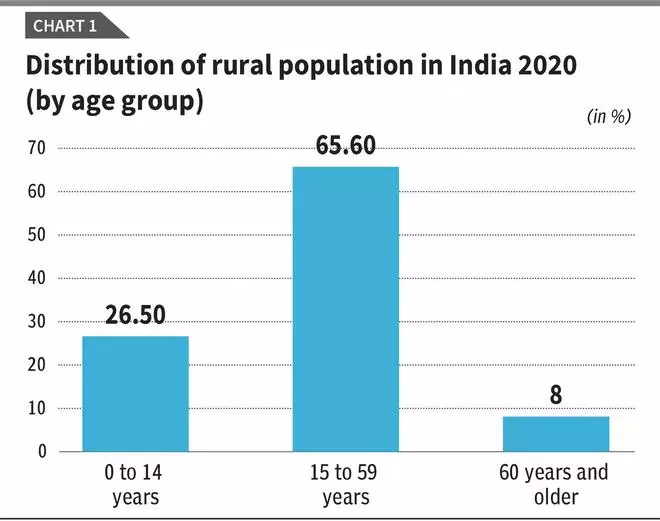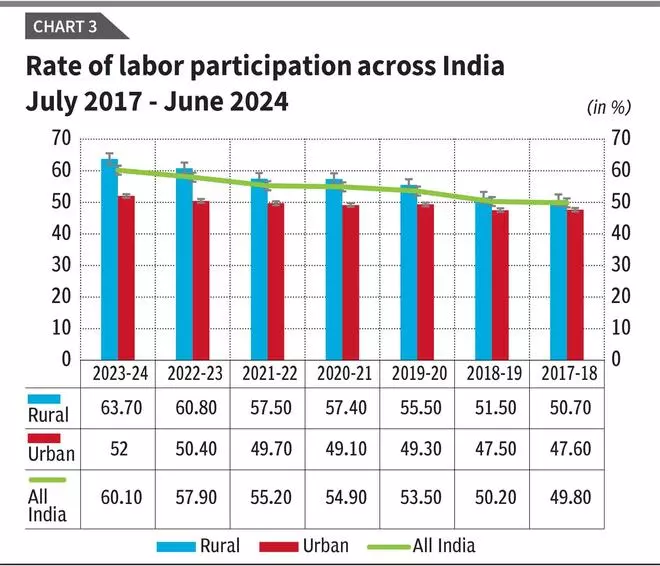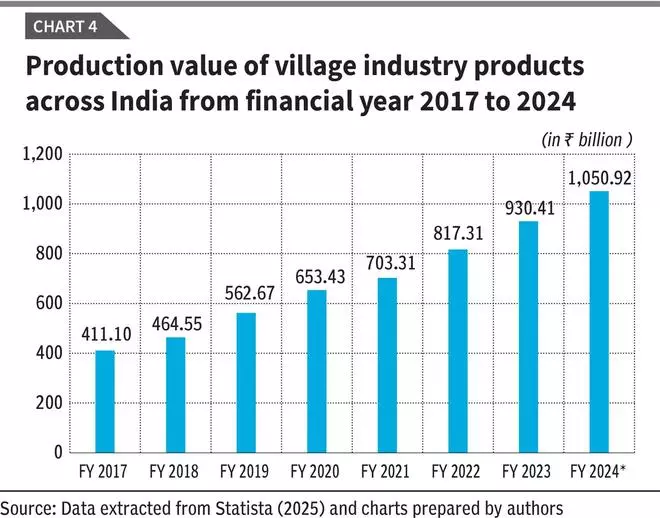Why is rural India important for economic growth and development? It is home to 65 per cent of India’s population with a majority of the rural population falling in the 15-59 years age group (Chart 1). Post-Covid-19, the rural labour force participation rate has increased than its counterpart (Chart 3). Also, the value of village industry products has increased significantly with a CAGR of 14 per cent from 2017 to 2024 (Chart 4). However, the All India Rural Financial Inclusion Survey 2021-22 reported per capita income for rural India is not even ₹100 a day.



So, a comprehensive multi-sectoral ‘rural prosperity and resilience’ programme partnering with the States, announced in Union Budget 2025–26, is a welcome move at the right time.
It intends to address under-employment in agriculture through skilling, investment, and technology, invigorating the rural economy and catalysing enterprise development. The Finance Minister highlighted that global and domestic best practices will be incorporated, and appropriate technical and financial assistance will be sought from multilateral development banks.
A few issues, therefore, need to be addressed: Can we propagate the smart village concept to advance rural resilience? How will best practices inform evidence-based policymaking for rural resilience?
Rural resilience, smart villages
Rural resilience means the capacity of rural regions to absorb adversities and shocks or disturbances, and adapt and transform themselves to maintain functions, structures, identities, and feedback to ensure a satisfactory standard of living for the rural populace.
Resilience has three interactive dimensions, namely economic, cultural, and ecological, aiming to improve economic prospects, enhance social cohesion, and preserve ecological resources and cultural heritage.
Smart villages are an enabler to rural resilience. These villages use ICT or digital technologies to improve the lives and livelihoods of rural people. Smart village programme, initiated by the Shyama Prasad Mukherji Rurban Mission, planned to develop 300 village clusters by 2019. However, the programme appears to have lost its sheen.
In 2016, a few States initiated the Smart Village Movement (SVM) supported by CSR or local area development funds. In association with the University of California Berkeley Centre of Growth Markets, a non-profit organisation, SVM demonstrates the potential of multi-sectoral collaboration to leverage synergies among economic, cultural, and ecological resilience central to rural resilience.
The SVM programme ensures sustainable rural development supported by technology, community knowledge, and ecological resources. Thus, developing rural resilience requires shunning a top-down, technocratic, siloed approach in favour of a bottom-up, participatory, and systems approach while designing and implementing the multi-sectoral programme for creating smart villages.
Such an approach utilises the knowledge, action, and commitment of rural people and collectives to shape and maintain their quality of life. Rural resilience inevitably involves negotiating the tragedy of commons. Thus, community-based organisations or public-private-community participation assume an instrumental role.
Furthermore, local leadership, collaboration, and social cohesion are important for rural resilience linking knowledge, innovation, and consensus spaces created in smart village clusters.
Way forward
First, smart village creation for rural resilience requires a bottom-up, holistic, and ‘social-cyber-physical systemic’ view. Leveraging one dimension of rural resilience at the cost of other dimensions does not result in sustainable development.
Second, smart villages allow dovetailing formal and informal knowledge to benefit rural communities and help negotiate scale barriers micro-enterprises encounter in serving their customers. These villages facilitate disintermediation helping rural producer groups and artisanal businesses in direct-to-consumer marketing.
Third, convergence of central sector schemes, CSR funds of corporations, and blended finance, including grants, concessional loans, and guarantees from multilateral development banks are needed to create smart village clusters for every panchayat. A synergy in programme design, financing, and implementation between multiple actors is crucial for sustaining smart villages.
Fourth, sustainable socio-economic pathways catalysed by smart villages can advance economic, cultural, and ecological resilience. Market infrastructure and organisational mechanisms are important for promoting more smart villages for rural resilience. Government, academia, industry, and civil society must make a concerted effort to achieve this.
To sum up, diversification of rural livelihoods using locally available resources, creating favourable market linkages, building supportive physical and social infrastructure, improved service provisioning, and maintaining the quality of the local ecological environment are indispensable for advancing rural prosperity and resilience.
Dey is an Associate Professor at IIM Lucknow, and Kumar is an Assistant Professor at IIM Calcutta. Views are personal





